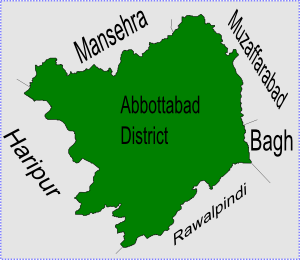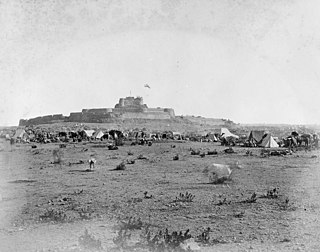
Amb or the State of Amb was a princely state in the present day Khyber Pakhtunkhwa region of Pakistan. Together with Phulra, it was known as Feudal Tanawal ruled by Tanoli tribe. A Royal Tenure start from Timurid Empire and end on Last Nawab Muhammad Farid Khan Tanoli. Amb was only powerful state incorporated in Pakistan with armed civilized military of 12,000 men, 300 Howitzer with their own manufacturing arms factory, today part of the Pakistan Army. Amb had a influence control roots in Swat, Dir and Chitral. A gaining of powerful roots of Amb military start from Second Anglo-Sikh War when East India Company provide military equipment to Jehandad Khan Tanoli to fight against Sikh, and then next British Empire in Second anglo-Afghan War. At the end of December 1947, the Nawab of Amb state acceded to Pakistan while retaining internal self-government. Amb continued as a princely state of Pakistan until 1969, when it was incorporated into the North West Frontier Province.
Jamrūd or Jam is a town in the Khyber District of Khyber Pakhtunkhwa, Pakistan. Located in the Valley of Peshawar, on the western fringe of Peshawar city, Jamrud is the doorway to the Khyber Pass which is just to the west of the town. The pass connects Jamrud with Landi Kotal to the west, located near the border of Afghanistan's Nangarhar Province.

Mansehra is a city in the Khyber Pakhtunkhwa province of Pakistan and the headquarters of Mansehra District. It is the 71st largest city in Pakistan by population and the 7th largest city in the province.

Hazara is a region in northern Pakistan, falling administratively within Hazara Division of the Khyber Pakhtunkhwa province. It is dominated mainly by the Hindko speaking Hazarewal people, who make up the many native ethnic groups of the region and often called the "Hazarewal".

Hari Singh Nalwa was the commander-in-chief of the Sikh Khalsa Fauj, the army of the Sikh Empire. He is known for his role in the conquests of Kasur, Sialkot, Attock, Multan, Kashmir, Peshawar and Jamrud. Hari Singh Nalwa was responsible for expanding the frontier of Sikh Empire to beyond the Indus River right up to the mouth of the Khyber Pass. At the time of his death, Jamrud constituted the western boundary of the Empire.

Maharaja Gulab Singh Jamwal (1792–1857) was the founder of Dogra dynasty and the first Maharaja of the princely state of Jammu and Kashmir, which was a part of Panjab and Sikh Empire became the largest princely state under the British Raj, which was created after the defeat of the Sikh Empire in the First Anglo-Sikh War. During the war, Gulab Singh would later side with the British and end up becoming the Prime Minister of Sikh Empire. The Treaty of Amritsar (1846) formalised the transfer of all the lands in Kashmir that were ceded to them by the Sikhs by the Treaty of Lahore.

Sherwan is a Tehsil from the Abbottabad District in the Khyber-Pakhtunkhwa province of Pakistan, located 35 km west of Abbottabad. Sherwan consists of two adjacent villages. The northern part is referred to as Sherwan Kalan, and the southern as Sherwan Khurd. Sherwan is on a ridge 5,000 feet high in the centre of Lower Tanawal.

The Battle of Jamrud was fought between the Emirate of Afghanistan under Emir Dost Mohammad Khan and the Sikh Empire under Maharaja Ranjit Singh on 30 April 1837. Afghan forces confronted the Sikh forces at Jamrud. The garrisoned army was able to hold off the Afghans till Sikh reinforcements arrived to relieve them.

The Jamrud Fort is located beside Bab-e-Khyber at the entrance to the Khyber Pass from the Peshawar side in the district of Khyber in KPK, Pakistan. After the death of Sardar General Hari Singh Nalwa, Khalsa Sarkar Wazir Jawahar Singh nominated General Gurmukh Singh Lamba as chief administrative and military commander to restore and consolidate the Khalsa army gains.

The Battle of Nowshera was fought in Nowshera in March 1823 collectively by the Yusufzai Afghans, supported by the Peshawar sardars, alongside Azim Khan Barakzai, the Afghan governor of Peshawar, where they would face the Sikh armies led by Maharaja Ranjit Singh. Azim Khan was a half-brother of Dost Mohammad Khan, the future ruler of Kabul, and later Afghanistan. The battle was a victory for the Sikhs over Azim Khan's armies, a result which allowed the Sikhs to begin their occupation of the Peshawar Valley.
Painda Khan Tanoli was a powerful chief and warrior in Tanawal area of North-West Frontier region of India. Painda Khan's rebellion against the Sikh empire cost him much of his kingdom, leaving only the tract around Amb, with its twin capitals of Amb and Darband.
The Battle of Shopian took place on 3 July 1819 between an expeditionary force from the Sikh Empire and Jabbar Khan, the governor of the Kashmir Valley province of the Durrani Empire. It was the decisive battle during the Sikh expedition into Kashmir in 1819.

The Sikh Rule in Lahore initiated from the conquest and rule of the Sikh Misls and extended till the Sikh Empire of Ranjit Singh which ended in 1849. The Sikhs began gaining power following the decline of the Mughal Empire in Punjab and consisted of a collection of autonomous Punjabi Misls, which were governed by Misldars, mainly in the Punjab region.
Bostan Khan, was a warrior of the Tareen tribe settled in the Haripur, Hazara region of what was to later become the North-West Frontier Province, who was executed for rebellion by the Sikh Empire administrators of the region at that time.
Mir Nawab Khan Tanoli was the ruler of The Tanawal valley and the Chief of the Hazara region from circa 1810 until he died in 1818. During his rule, he faced many attacks from the Sikh Empire and Durrani Empire, resulting in a significant loss of territory. He was 26 years old when he was assassinated by Azim Khan on October 13, 1818 in the Stratagem of Peshawar.

The Standoff at the Khyber Pass (1834–1835) was a short conflict from May 1834 to May 1835 between the Sikh forces led by Maharaja Ranjit Singh and the Afghan forces led by Dost Mohammad Khan. The conflict began as the Sikh Empire expanded into Peshawar, deposing the Peshawar Sardars, while also supporting the deposed Durrani dynasty in their attempts to return to the throne of Afghanistan under Shah Shuja Durrani.

The Military campaigns of Hari Singh Nalwa were a series of conquests and battles in which the Sikh Empire commander Hari Singh Nalwa fought from 1807 to 1837. His first battle was fought against the Durrani Empire. With his help, the Sikh Empire managed to expand over a large land area, spanning from Jamrud to Tibet. He was killed in the battle of Jamrud at Khyber Pass in 1837.

The siege of Mankera, also known as the fall of Mankera was a conflict from 7 December 1821 to 1 January 1822 between the Sikh forces led by Maharaja Ranjit Singh and the Mankera forces led by Nawab Hafiz Ahmad Khan.
The Battle of Taragarh was fought in 1822 by the Sikh forces led by Amar Singh Majithia and the Afghan tribesmen led by Mohammad Khan Tarain.
The Gibariddynasty consisted of the members of the royal House of Pakhal, later known as House of Jahangir, after the fifth ruler of dynasty known as Sultan Jahangir Gibari. According to Gibarids tradition, the family originated from the Gibari tribe, a branch of the Iranic tribes, under Pakhal I. The Gibarid dynasty, named after Sultan Pakhal Gibari I, ruled the Sultanate of Swat from c. 1190 to 1519.












